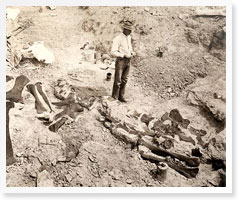Excavation
Fieldwork, involving prospecting for, excavating and collecting fossils, is what most people think of when they hear the word paleontology.
Popular culture references to excavation make it seem exciting and glamorous. While it certainly can be thrilling to be the first person to find a fossil that has been buried for millions of years, most excavation is careful, painstaking and often tedious work. This is because the information associated with the specimen is as important as the actual fossil, and fossil collection often is as much about collecting data is it is about collecting specimens.

The complete scientific value of the specimen is determined by these data. For example, the sediments around the fossil can help establish its age. The presence of other fossils in the site can give us insights into the climate and ecology of the organism, while their position and relation to each other can show, for example, how the animals died and what happened to the bodies after their death. Collectors, whether amateur or professional, have to collect as much contextual information as their expertise allows. As the Society of Vertebrate Paleontology Policy Statement on Collecting states: "even if the fossils legally remain in private collections for some time…the scientific and educational value of the fossils depends on their contextual information as well as their morphology."
This website is not a resource for excavation techniques, but there are many useful resources available on the internet (see links below). For information on a recent fossil discovery in Chile click here.
Collecting Tips
- If more than one institution is involved in collecting, it is a good idea for the institutions to have a written agreement setting out, for example, whether the fossils that are collected will go to one institution or be divided between different ones, or how the collection will be used for research and who will have the right to work on it. Ideally this agreement should be in place before the fieldwork commences. This is particularly important when collecting in another country
- Make sure that you have all the relevant permissions in place from local, state, and national authorities, and from any private landowners. Finding out what permissions are required may be a lengthy process, especially if the fieldwork is taking place in another country.
- Retain copies of collecting permits, together with any other documentation in accession files or notebooks.
- The collection of material must follow the conditions specified in any permits granted, as well as any collection policy strategies set down by the institution.
How do I obtain permission to collect?
It is important that all paleontologists follow the basic tenets of good collecting. The first, and most important, is that all fossil collecting, whether on public or private lands, requires you to obtain the proper permission. Depending on where you collect, this may involve getting permission from a private landowner, a state or federal agency, a tribal council, or some other group. For private landowners, a letter of permission may be sufficient, but for most other groups or organizations a formal permit will be required, which will specify what material can be collected and where it will ultimately be housed. In general, collection of fossils on public lands is only allowable if the fossils will be in a public repository. In some situations, you may be required to pay a fee to collect. Policies on what may be collected and where vary widely according to federal, state and local regulations, and it is your responsibility to research and understand this thoroughly. You may also have to undertake extensive research into land ownership to ensure that you are getting permission from the right person and in the right way.
Institutions or private collectors acquiring specimens during field research and expeditions must do so with the agreement of, and in compliance with the laws of the host state, government or country. In the case of importation of foreign specimens, it is the responsibility of the collector to ensure compliance with all applicable State, Provincial, Federal or other appropriate governmental laws.
For more information on permits check some of the following links.
- Bureau of Land Management
- National Park Service
- In particular, institutions should consult 36 CFR 79: Curation of Federally-Owned and Administered Archaeological Collections and the National Park Service handbook on Managing Archaeological Collections.
What kinds of data and records should I keep in the field?
As we’ve already discussed, much of the value of fossils comes from their contextual information. For this reason, it is essential that both amateur and professional collectors record as much information as possible about their fossils’ provenance in terms of stratigraphic, geographic, taphonomic and paleoenvironmental information.

It is important that the field data, whether in the form of notebooks, photographs, videos, electronic files, or any other format, always accompany fossils to wherever they are ultimately stored. Original field data (or a legible copy of it) should become part of the fossil collection or related archives, and should always be passed on with the fossils if the collection is donated to or deposited in another institution.
In an excavation a catalog generally is maintained, where excavation numbers are assigned to specimens as they are collected. This number is used to associate the relevant excavation information until the specimen is cataloged.
For more information on data and record keeping see specimen data.



